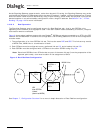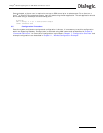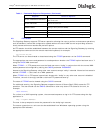
21
Dialogic
®
SS7G2x Signaling Server SGW Mode User Manual Issue 4
4.3 Command Character Set and Syntax
The only characters used for commands and parameters are:
• The letters A to Z and a to z, referred to as <letter>. The case of characters in command names and
parameter names is not significant.
• The digits 0 to 9, referred to as <digit>
• - (hyphen), CR (FE5), SP (space), $(dollar), & (ampersand), * (asterisk),
: (colon), ; (semicolon) / (solidus), . (full stop/period) and = (equals sign)
• The DEL (Delete) character or the BS (Backspace) character is used to delete characters on the current
line.
• The CAN character (Ctrl X) is used as an abort character.
It is possible to indicate several simple values for the same parameter by grouping parameter arguments
using the operators & or &&. For example, 3&6 indicates the simple parameter arguments 3 and 6. A
sequence of consecutive simple parameter arguments is indicated by writing the lower and upper simple
parameter arguments separated by &&, hence 4&&8 indicates the simple parameter arguments 4, 5, 6, 7
and 8.
Comments are allowed in command input, and can appear in any position on the command line. A comment
is defined as a character string enclosed between the separators /* (solidus asterisk) and */ (asterisk
solidus), where the character string can contain any characters except the format effector characters (HT –
Horizontal Tab, LF – Line Feed, VT – Vertical Tab, FF – Form Feed and CR – Carriage Return) and the
sequence */.
4.4 Command Formats
To allow easy command recognition and familiarization, all the commands share a common five character
format:
XXYYZ
where:
• XX = Command group
• YY = Function within group
• Z = Operation code
The following operation codes are used:
• C = Change
• E = End
• I = Initiate
• P = Print
• S = Set
Note: The term “print” refers to output to the serial port in use for the dialog procedure.
4.5 Command Entry
Each character entered is echoed to the operator’s terminal. The BS (backspace) or DEL (delete) character
can be used to delete characters entered within the current line. This causes the Signaling Gateway to output
the sequence BS space BS. On a visual display terminal, this has the effect of deleting the last character
entered from the display.
Commands can be entered whenever the command prompt has been output. Commands are terminated by
a semicolon (;) followed by CR. Commands may exceed one line on the terminal, but may not exceed 100
characters.
If a command takes parameters, a colon is used to separate the command from the parameters. A comma
(,) is used to separate multiple parameters.


















